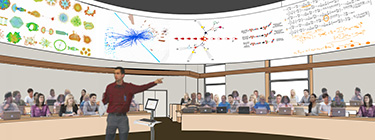|
Subscribe / Renew |
|
|
Contact Us |
|
| ► Subscribe to our Free Weekly Newsletter | |
| home | Welcome, sign in or click here to subscribe. | login |
Construction
| |
 |
November 19, 2015
Classroom of the future takes shape at WSU— and it's round
Vantage Technology Consulting Group

Rhoads
|
Vantage Technology Consulting Group is designing comprehensive, cutting-edge teaching and learning systems for Washington State University’s new Digital Classroom Building, in collaboration with Clark Construction and ZGF Architects.
The striking new 80,000 square foot facility will serve as a gateway, showcase venue and catalyst for WSU’s campus-wide initiative to address the tremendous advances that have been made in understanding the way students learn in the 21st century.
Vantage has worked closely with the WSU administration, faculty and students to provide robust designs that allow flexibility in teaching modes, address the way students learn and create learning across multiple disciplines.
With this project we are offering a “true path” to innovation: classroom technology that is designed around the institution’s vision for pedagogy in the future (and not the other way around.)
These innovations include adaptable learning spaces, places for technology-enhanced collaboration, and specialty experimental and hands-on skill-building platforms. Here are a few examples:
Adaptable learning places
• The active learning hall is a rounded open-floor space where lecturers can feel close and connected to participants, roaming freely and able to collaborate within an innovative technology-rich environment.
This space addresses evolving struggles with the traditional large-seat auditorium in a modern teaching environment. By placing the instructor in the middle, surrounded by students in fewer rows, the sense of communal learning is strengthened.
A 360-degree ring of display screens helps to further the experience of shared storytelling and discovery, and additional technology for wireless sharing of screens allows for some teaming and student-contribution activities that have never been possible before.
• Flexible flat-floor classrooms with intuitive technologies will support presentation, instruction, active learning collaboration, and communication within the classroom and across the globe.
• A central lobby common area will tastefully evoke the excitement of the space and instantly transform for use as a public presentation or event space.
Tech-enhanced collaboration
• The building will offer a learning ecosystem that tailors itself to the educational needs of each individual with robust data, power and access to key information like building schedule and room availability.
• Active learning labs are where classes of up to 120 students sit at six-person group tables sharing a table, facilitated by an instructor on hands-on digital learning activities. All tables are interconnected through technology to allow students to interact seamlessly and share in the learning process.
• Problem-based learning, open informal learning and other small “huddle spaces” are where students and instructors can gather for informal learning with collaborative technology that’s available when needed but not in the way.
• The student skills studio and faculty test kitchen, located within the academic resource center, is designed to encourage users to experiment, gain confidence and push frontiers with access to new and emerging collaboration and digital media technologies.
Skill-building platforms
• The “maker space” will have tactical-grade mobile presentation and conferencing appliances to enhance development projects.
• Room and centralized technologies will offer logistics-free blending of online, remote (distance learning) and classroom/face-to-face learning.
The Digital Classroom Building is expected to energize and enable students and faculty, provide support for students and faculty to learn new technologies, and create a nexus between the adjacent academic and housing facilities.
Occupancy is scheduled for the first quarter of 2018.
Parke Rhoads is a principal at Vantage Technology Consulting Group.
Other Stories:
- No detail is too small for UW nanoengineering lab
- How crews used BIM to cope with unwelcome surprises at Denny Hall
- New UW dorms revive a long-lost urban pathway
- UW, WSU find ways to do more with less
- WSU’s Paccar building houses 5 R&D labs
- WSU’s wine center aims to train next generation of winemakers
- UW: Top 10 capital projects
- WSU: Top 10 capital projects



